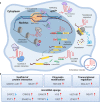Long non-coding RNAs in brain tumors: roles and potential as therapeutic targets
- PMID: 33980320
- PMCID: PMC8114507
- DOI: 10.1186/s13045-021-01088-0
Long non-coding RNAs in brain tumors: roles and potential as therapeutic targets
Abstract
Brain tumors are associated with adverse outcomes despite improvements in radiation therapy, chemotherapy, and photodynamic therapy. However, treatment approaches are evolving, and new biological phenomena are being explored to identify the appropriate treatment of brain tumors. Long non-coding RNAs (lncRNAs), a type of non-coding RNA longer than 200 nucleotides, regulate gene expression at the transcriptional, post-transcriptional, and epigenetic levels and are involved in a variety of biological functions. Recent studies on lncRNAs have revealed their aberrant expression in various cancers, with distinct expression patterns associated with their instrumental roles in cancer. Abnormal expression of lncRNAs has also been identified in brain tumors. Here, we review the potential roles of lncRNAs and their biological functions in the context of brain tumors. We also summarize the current understanding of the molecular mechanisms and signaling pathways related to lncRNAs that may guide clinical trials for brain tumor therapy.
Keywords: Brain disease; Genomics; Glioma; LncRNA; Neurodegenerative disease.
Conflict of interest statement
The authors declare no competing financial interests.
Figures



References
Publication types
MeSH terms
Substances
LinkOut - more resources
Full Text Sources
Other Literature Sources
Medical

